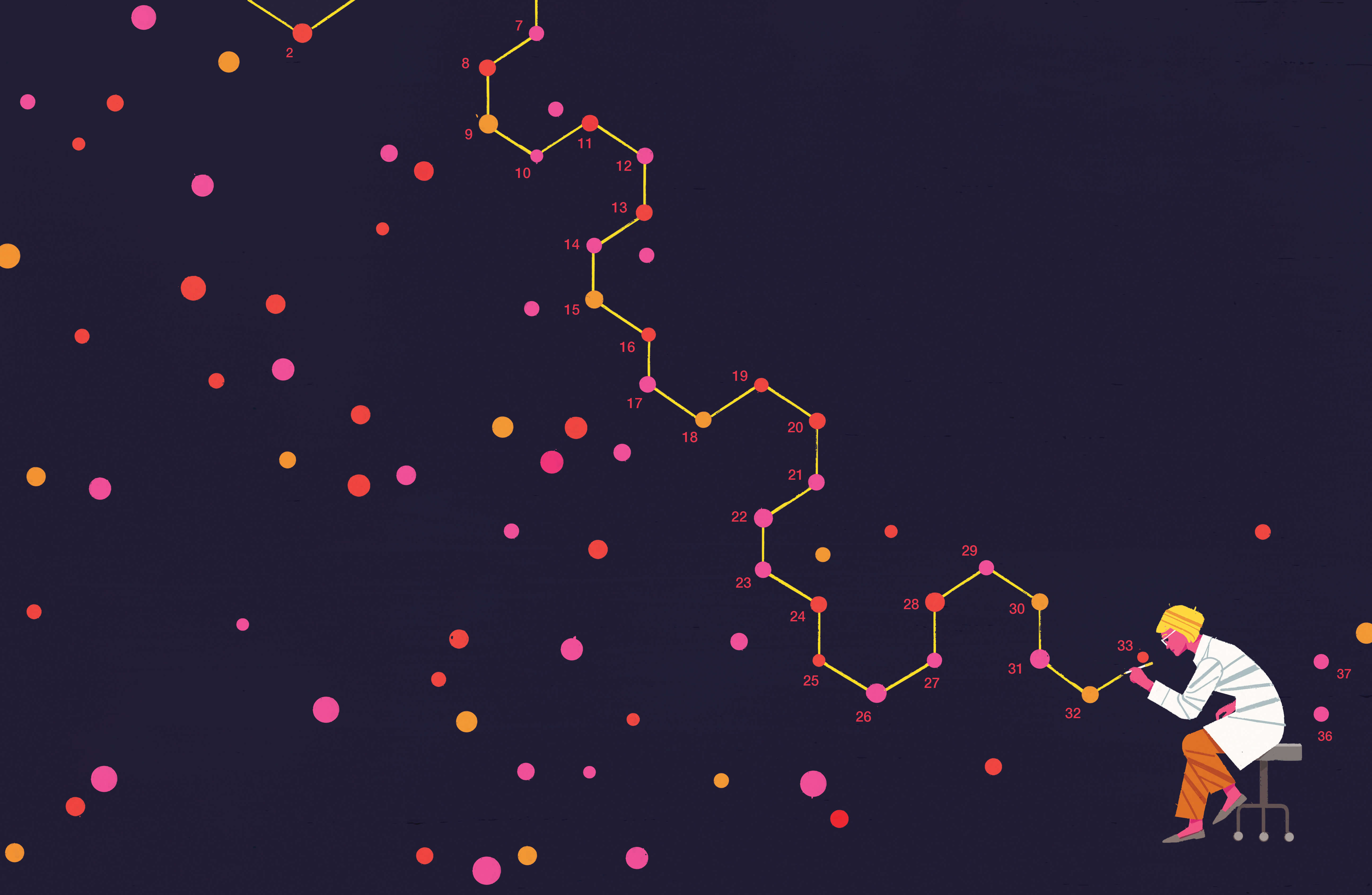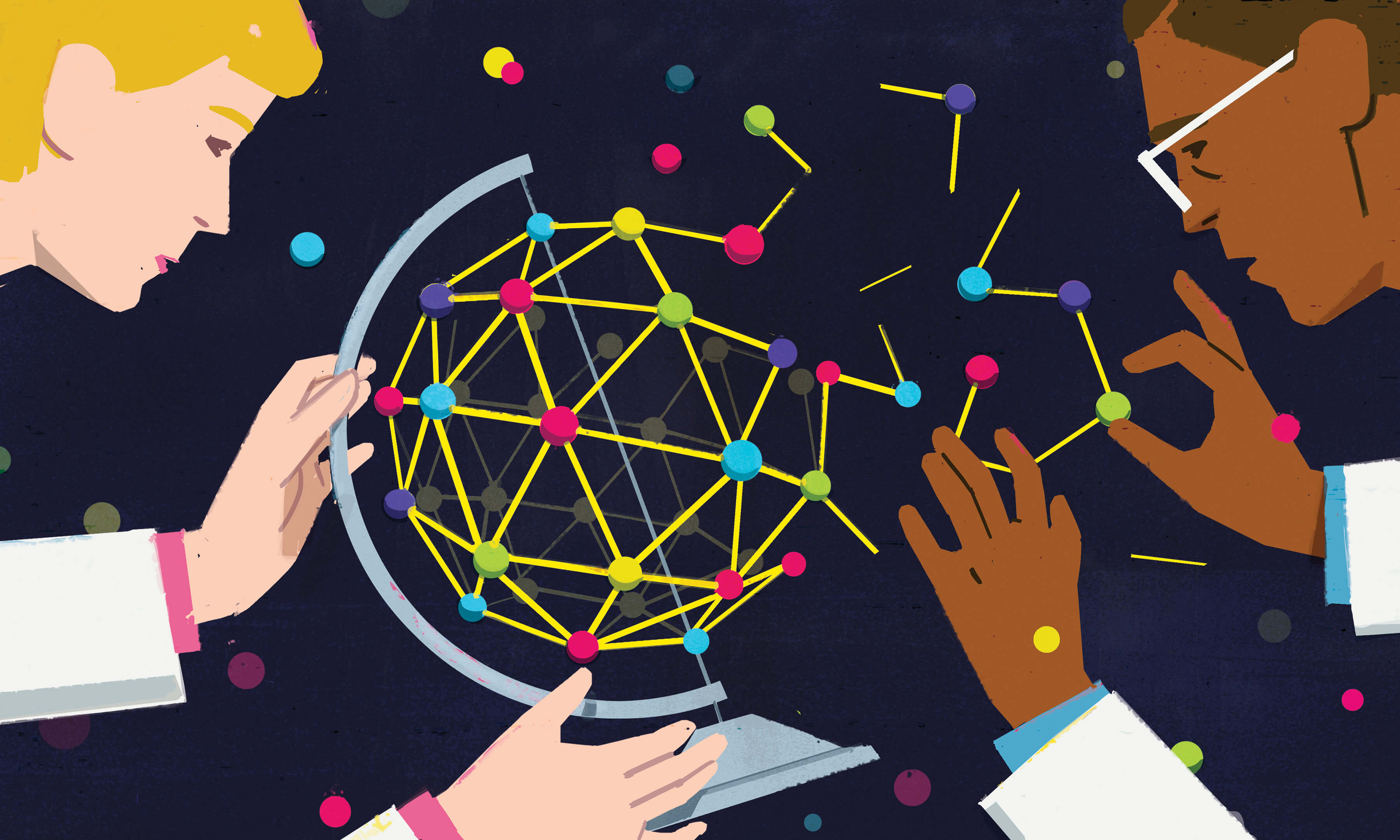
Molecular Connections
A collaborative research initiative is bringing students and professors together to explore new possibilities in cancer therapy.
Inside the labs of Edison Hall, an innovative collaboration between the chemistry and biology departments is helping to advance cancer research while also shaping the next generation of scientists. Led by Professors Greg Moehring, Datta Naik, and Jeffrey Weisburg, the project gives undergraduate students hands-on experience synthesizing new rhenium-based molecules and testing their ability to selectively kill cancer cells while sparing healthy ones. Although still in its early stages, the work has the potential to inform future cancer treatments while equipping students with skills that will benefit them after they graduate.
The project started in 2017 when Naik, a chemistry professor, came across a research paper describing a rhenium-based molecule that had a rare alkylcarbonate group that showed potential for killing certain cancer cells. He shared the paper with Moehring, an associate professor of chemistry, who was equally intrigued.
“I’ve been a faculty member for 36 years, and I had never seen this particular organic portion of a molecule bound to a metal center,” Moehring recalled.
Their curiosity piqued, they decided to explore the chemistry further by creating analogs of the reported molecule, enlisting undergraduate students to assist with the exploration. The team began by synthesizing the original alkylcarbonate-containing molecule described in the paper and then modified it through reactions with various acids. The modifications replaced the alkylcarbonate part of the molecule with a portion of the acid substance. They then isolated the resulting solids from the reactions and used nuclear magnetic resonance and infrared spectroscopy to characterize the new molecules they made, Moehring said.
The project gained further momentum after Moehring shared the team’s early work at a School of Science research roundtable. Weisburg, a specialist professor of biology who researches cancer, approached Moehring afterward and offered to test the new molecules on cancer cells and normal cells to determine their ability to selectively kill cancer cells.
The collaboration added an exciting new dimension to the research, Moehring said, since much of the work done by inorganic chemists—including the paper that initially inspired this work—focuses solely on how compounds affect cancer cells. Weisburg’s involvement allowed for a more comprehensive analysis, helping the team better understand their molecules’ potential to selectively target cancer cells while sparing healthy ones—a key goal for any potential cancer treatment.
Weisburg and his students began testing the compounds by exposing oral cancer cells and their normal counterparts to the molecules for 24 hours, which is the time it takes for the cells to divide. They then added a fluorescent dye to the cells, altering their structures so that they emit light when struck by a laser. Using specialized instrumentation, they then measured the fluorescence to determine the percentage of living cells remaining based on the intensity of light emitted.

“The more light that’s given off, the more cells are alive,” Weisburg said.
The team’s findings were encouraging, and last summer, the researchers published a paper in Inorganica Chimica Acta, a peer-reviewed scientific journal, which detailed three carboxylate-stabilized rhenium(I) complexes they had created, two of which showed significant potential in selectively killing oral cancer cells.
According to Moehring, the stability of the molecules was the key to their effectiveness.
“We make material that’s a solid, and to test that on cells, Jeff’s team has to make a solution of the material in water and a second solvent,” Moehring said. “When they make that solution and introduce it outside of the cells … those molecules can start undergoing chemical reactions before they even enter the cells.”
The researchers believe that the less-cytotoxic molecule underwent additional chemical reactions outside the cell, whereas the other two molecules remained intact and were therefore better able to enter the cell.
“Once they’re in the cells, their reactivity, their mechanism, seems to imitate the mechanism of the available platinum cancer drugs,” Moehring said.
Building on those results, the team has been working to create molecules that light up when exposed to ultraviolet light. That would help them see where in the cells their rhenium molecules are going, which in turn would help them understand how their molecules are killing the cancer cells, Weisburg said.
Along the way, a new challenge emerged: enhancing the fluorescence of their new molecules enough to distinguish them from naturally occurring cellular fluorescence.
“Unfortunately, they don’t light up very brightly,” Moehring explained. “It’s like turning on a dim light bulb versus turning on a bright one, and the molecules that are native to the cell are also lighting up.”
As the researchers work to refine the fluorescence in their molecules to make them stand out more, they are also hoping to tackle another challenge: securing external funding that would enable them to expand their work. To date, the project has been funded by the University using materials Moehring, Naik, and Weisburg have in their labs. External funding, through grants or private support, would allow them to purchase more materials for synthesis and testing. Much of the money, though, would provide stipends for students, allowing more undergraduates to benefit from this sort of mentored research experience, Moehring said.
“It is really interesting to do independent research like this, because you’re adding new knowledge to the field,” said senior Lyndsey Buren, whose work on the project earned her a co-author credit on the paper that was published last summer.
One of more than 20 undergraduates to contribute to the project over the years, Buren worked on the synthesis team under the mentorship of Moehring and Naik. She said that unlike in traditional lab courses, where students follow a predefined set of instructions, she had to devise, refine, and adapt her experimental procedures, often learning as much through failure as success. Being freed of the 14-week time constraint that comes with in semester work also gave her the flexibility to dive deeper into specific problems.
Altogether, the experience helped her gain confidence in the lab, learn new experimental techniques, and develop her problem-solving and critical thinking skills, Buren said. Additionally, presenting and publishing her work improved her ability to communicate complex scientific data to a variety of audiences.
“These are transferable skills … that I believe will be valuable for me in the future,” Buren said.
Beyond these practical skills though, the experience “changed my life and my trajectory,” she added. Originally a medical laboratory sciences major, Buren said working on the project inspired her to take on a second major, chemistry, and that she now plans to pursue an advanced degree in the field after graduating this May.
So, while the team’s work has the potential to one day contribute to advancements in cancer treatment, it is experiences like Buren’s that show the project’s immediate impact. By providing students the opportunity to do exploratory research and discovery on a real-world problem, the project is sharpening their scientific skills, fostering their critical thinking, and deepening their understanding of chemical and biological processes—skills that will benefit them regardless of whether they choose to pursue graduate or medical school or enter the workforce. For the faculty leading the project, that impact is every bit as meaningful as the scientific discoveries made along the way.
“That’s really the driving force for us: to see our students grow and learn,” Naik said.